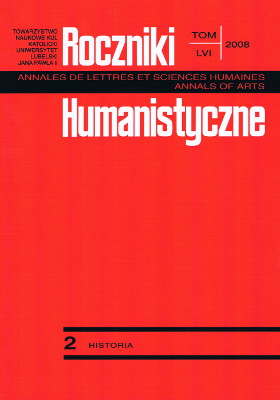The Establishment and Development of the Parysów Parish against the Backdrop of Settlement in South-East Masovia
Abstract
The parish in Parysów was erected in 1445 by the Poznań bishop Andrzej Bniński. It originated in a gentry foundation. One of its founders was Parys of Sieczcza, the progenitor of a family of officials well-known in the following centuries in Masovia. The foundation of the parish followed settlement in the first half of the fifteenth century, and it was beneficial for further processes of settlement in this territory. Almost an entire century later Florian Parys, Parys’s grandchild, established a town here that retained its urban rights until the nineteenth century. Until 1564, the parish was composed almost exclusively of the villages that belonged to the Parys family. In 1546 the area of the parish was enlarged almost by one third, i.e., the villages of the royal estate from the parish of Osieck (the Osieck starosty) were included. The parish occupied then the area of ca. 100 square km. In such a shape, with some changes in the seventeenth century, the parish survived until the end of the Polish Republic. During several centuries, Parysów with its adjacent villages belonged to the more or less prosperous noble families. In the eighteenth century the estates were taken by the Bieliński family, an influential aristocratic family that possessed numerous territories in this part of Masovia. Unfortunately, it did not much affect the development of the town, for its population was mainly occupied with agriculture.
References
Biernacka M., Wsie drobnoszlacheckie na Mazowszu i Podlasiu, Wrocław 1966.
Kociszewski A., Garwolin w latach 1795-1864, w: Garwolin. Dzieje miasta i okolicy, Warszawa 1980, s. 117-138.
Litak S., Kościół łaciński w Rzeczypospolitej około 1772 roku. Lublin 1996.
Litak S., Sieć szkół parafialnych w Rzeczpospolitej w XVI i w pierwszej połowie XVII w. Próba podsumowania, „Rozprawy z Dziejów Oświaty” 37(1996), s. 21-35.
Olczak S. K., Duchowieństwo parafialne diecezji poznańskiej w końcu XVI i w pierwszej połowie XVII wieku. Lublin 1990.
Piętka J., Fałszywe, niepewne i podejrzane dokumenty mazowieckie z pierwszej połowy XIII w., „Przegląd Historyczny” 86(1997), s. 289-315.
Wiśniowski E., Badania nad początkami i rozwojem średniowiecznej sieci parafialnej na ziemiach polskich, w: Discernere vera et falsa. Prace ofiarowane Józefowi Szymańskiemu w sześćdziesiątą rocznicę urodzin, Lublin 1992, s. 43-55.
Wyrobisz A., Rola miast prywatnych w Polsce w XVI i XVI w., „Przegląd Historyczny” 65(1974), z. 1, s. 19-46.
Żebrowski T., Kościół (X-XI11 w.), w: Dzieje Mazowsza do 1526 r., red. A. Gieysztor, Warszawa 1994, s. 132-162.
Żebrowski T., Kościół (XIV - początek XVI w.), w: Dzieje Mazowsza do 1526 r., red. A. Gieysztor, Warszawa 1994, s. 327-361.
Copyright (c) 2008 Roczniki Humanistyczne

This work is licensed under a Creative Commons Attribution-NonCommercial-NoDerivatives 4.0 International License.





